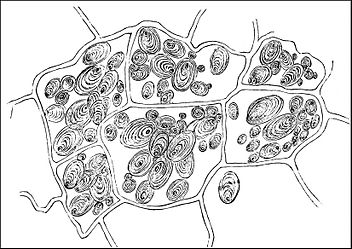stances, but one or two examples will suffice. Perhaps the most familiar vegetable product is starch, certainly interesting since it enters so largely into the daily food of the world. Let us make a thin section of a common potato and examine it for a moment (Fig. 7). See what a multitude of tiny spheres and ellipsoids crowd the cells! If we apply to our section iodine, we introduce the test of color. The little solids take on a bright-blue tint, and so prove themselves

Fig. 7.—Potato-Cells, containing Starch-Grains.
starch. Now we can see why the potato forms so nutritious an article of diet. During fall and winter starch-grains, such as we have just seen, fill the cells of apple-twigs and of branches of various kinds, and form the basis for that lavish expenditure of plant-force by which our orchards and woods are made glorious in the sudden inflorescence of spring.
If we make a section of the petiole of a begonia-leaf, we may find cell-contents as remarkable as beautiful. Here are plainly crystals with their symmetrical, angular outline. Some of the mineral substances brought through the plant by currents ascending from the roots have found room in the cells of the leaf-stalk to shoot the rays of minute crystals, and here the crystals lie, sometimes a dozen jewels in a single setting (Fig. 8).
But the interest attaching to plant-cells does not culminate in chlorophyl, nor yet in starch-grains and crystals. The chlorophyl, as we have seen, owes its allegiance to the light, the starch to the chlorophyl, and the crystals to the water and the soil; but back of all this, and behind all this, though intimately united with it all, is that which owes its homage to none of these—which moves all, controls all, uses all, builds the cell-wall, and inhabits it—is, indeed, the active principle by which chlorophyl becomes efficient, by which the inorganic is lifted
